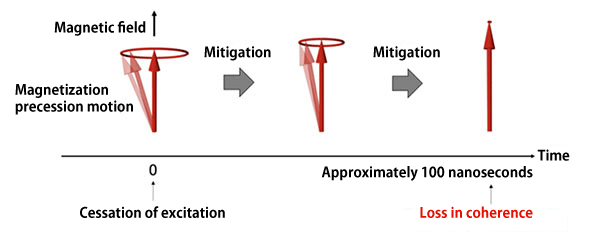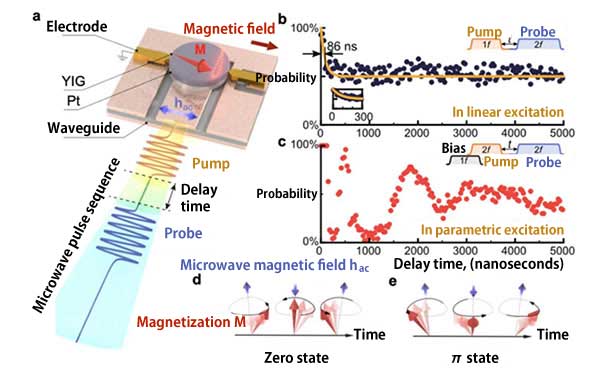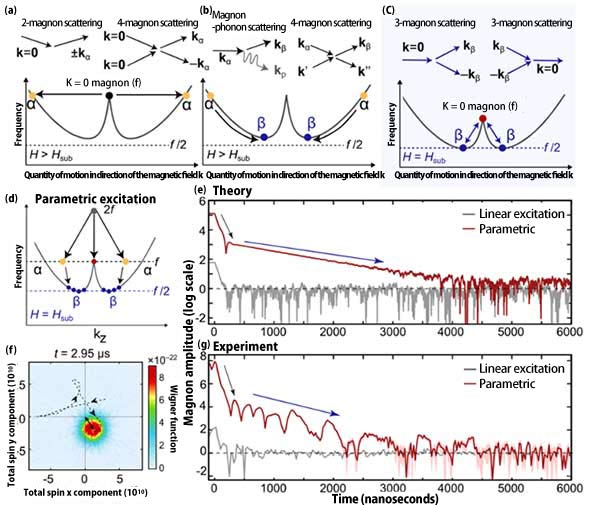Research Results
Path to the Development of a Novel Magnetic Information Device
Extraction of Hidden Oscillation Information in MagnetsFY2025

- SAITOH Eiji (Professor, Graduate School of Engineering, The University of Tokyo and Principal Investigator, Advanced Institute for Materials Research, Tohoku University)
- CREST
- Research Director (2020-2025), Information Carriers Area: "Non-classical Spin Integrated System"
Development of novel measurement method to extract magnetic oscillation information within magnets
A research group represented by Professor Eiji Saitoh at the Graduate School of Engineering, The University of Tokyo, has developed a novel measurement method (pump-probe measurement) to detect magnetic oscillation information (coherence), which was previously believed to exist only briefly―on the order of approximately 100 nanoseconds (nano: one billionth) within magnets. Using this method, the group discovered a mechanism by which magnetic oscillation can inconspicuously persist for a significantly longer duration of approximately 5000 nanoseconds, and further demonstrated that such information can indeed be retrieved.
Although coherence in magnets can potentially be used as a substitute for a bit, the smallest unit of information ("0" and "1"), its inherently short lifespan has made practical application challenging. The research group believes that this demonstration of the ability to retrieve hidden magnetic information will pave the way for the development of novel magnetic information devices.
Toward the realization of magnetic information devices that operate at room temperature
Various information can be obtained from magnetic oscillation. For example, the speed of magnetic oscillation provides information on the types and spatial distribution of substances, which is useful for elemental analyzers and medical diagnostic equipment.
Additionally, the application of an oscillating magnetic field to magnets (ferromagnetic materials) enables the generation of a magnetic oscillation state. Some magnetic oscillations, in which atomic-level micro-magnets (spins) move collectively, can exhibit a binarized phase, enabling correspondence to the '0' and '1' of a bit depending on the direction of the spins. By taking advantage of this property, magnets may help realize computing that is both fast and energy-saving. However, a major challenge to its practical application was the issue that coherence is lost in an extremely short period of approximately 100 nanoseconds (Fig.1). If coherence information could be retrieved even after a certain degree of extended time, it might become applicable to magnetic information devices.
The research group aimed to develop a new experimental method to measure coherence and endeavored to verify mechanisms by which coherence can exist.

Fig.1 Conventional magnetization precession motion
Measurement using parametric excitation and verification by a theoretical model
A large number of spins exist in magnets in a state that is aligned with the direction of the magnetic field (magnetization). When an oscillating magnetic field (microwave) is applied from the outside, the spins experience a force and simultaneously oscillate around the magnetic field (precession, Fig. 1). The coherence of this oscillation is maintained as long as the microwaves are continuously applied from the outside, but it is damped due to dissipation once the microwaves are turned off, leading to the loss of coherence in an extremely short period.
In this research, the research group developed a new measurement method (pump-probe measurement) to extract coherence information after the external force is removed (Fig.2). This method uses "parametric excitation," which is based on the same principle as standing and pumping on a swing. When standing and pumping on a swing, the vertical movement of the body causes the swing to reach a large amplitude. In the same way, parametric excitation periodically changes the resonance frequency (a parameter) and induces oscillation of half the frequency. The important point here is whether the swing moves forward (zero phase) or backward (π phase) at the moment the excitation starts. For example, if the probability of realizing the zero phase is higher, it indicates the existence of zero-phase coherence in the swing.
The research group repeated this measurement method numerous times to investigate how long the coherence in magnets can persist. First, as a reference, they applied a force at the resonance frequency and performed the measurements. As expected, the coherence was lost after approximately 100 nanoseconds, and the probability of zero-phase dropped to 50%. In other words, the result became as random as a coin toss. Next, they applied a force at twice the resonance frequency to excite parametric excitation of magnetization and performed the same measurement. To their surprise, they found that the oscillations continued for extended time of approximately 5000 nanoseconds. Needless to say, since the magnetization precession itself is lost in approximately 100 nanoseconds, this result indicates that coherence had been "hidden" for about 5000 nanoseconds.
To explain this probability oscillation, the research group developed a theoretical model and performed validation experiments (Fig.3). They devised a theoretical model in which coherence information is embedded in the motion at half the frequency and is later retrieved at the original frequency. In the validation experiment, they used state tomography*1, which acquires the amplitude, phase, and fluctuation of the magnetization precession, to observe the temporal variation of the amplitude. As a result, they successfully observed the appearance of two characteristic slopes that were the same as those in the theoretical model.
The results demonstrated the existence of a mechanism that can retain magnetic oscillation information for a duration 50 times longer than the previously assumed coherence period, and verified the ability to retrieve such hidden information.
*1 State tomography
An experimental method to identify the probability distribution function (Wigner function) that characterizes the physical state through projective measurement of the targeted physical system . The Wigner function is a function of dynamical variables that are in a canonical conjugate relation*2, like position and momentum, with the mean value of the distribution representing amplitude and phase, and the spread representing fluctuation.
*2 Canonical conjugate relation
A relation in which two quantities correlate with each other and cannot be clearly distinguished. In quantum mechanics, the values of two physical quantities in a canonically conjugate relation cannot be measured simultaneously (uncertainty principle) and are observed to fluctuate with a certain degree of error.

Fig.2 Concept and results of the measurement method (a) Schematic diagram of pump-probe measurement, (b) results when the pump is a linear excitation, (c) results when a parametric pump pulse is applied, (d) schematic diagram of the zero phase state, and (e) schematic diagram of the π phase state.

Fig.3 Conceptual diagram of the theoretical model and experimental results (a-d) Frequency-momentum relation (dispersion relation) for magnons (quanta of spin waves), (e) temporal change in magnon amplitude obtained by numerical calculation based on the theoretical model, (f) trajectory of magnon Wigner function obtained by state tomography measurement, and (g) temporal change in magnon amplitude obtained by state tomography measurement.
Contribution not only to the development of novel magnetic information devices but also to materials and condensed-matter physics
The research group believes that the discovery of magnetic oscillation hidden in magnets and the ability to retrieve this information have opened up the possibility of developing new magnetic information devices. The information retention mechanism discovered here will likely impact not only the fields of spintronics and magnetism, but also broad areas in materials physics and condensed-matter physics. Further, when integrating magnetic materials into nanometer sizes for use in computing elements and memory, this principle will enable the use of hidden coherence.
Going forward, the research group anticipates that magnetic physics will advance in a manner that integrates with various areas in quantum condensed-matter physics.
